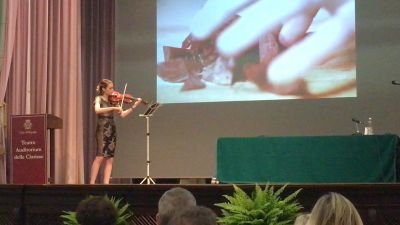Leslee Smucker ’09 delights eyes and ears with multimedia music project

When Leslee Smucker graduated from Goshen College in 2009 with a music major and an art minor, she took the interdisciplinary spirit of a liberal arts education with her. Now a doctoral candidate at the University of Colorado Boulder, the violinist has created a unique project called “Personae” that explores the musical and literary style of the poet Ezra Pound.
“I really wanted to do something that enriched all parts of the artistic experience,” she said. “I wanted it to be something that wouldn’t take away from each part, but make it better as a whole.”
Pound, one of the influential members of the modernist movement, is best known as a poet, but he was also a composer. Smucker said that his music and poetry have a similar style and emotional content, although the tone varies between pieces.
“Any time someone who’s known for something artistically does something in another artistic field, I think that’s really interesting,” said Smucker.
That interest is reflected in the content of the recital — Smucker performs on solo violin, accompanied by film and poetry in certain areas.
“Ezra Pound uses a lot of poetic influences in his music, and so his two pieces that are in the program are sestinas,” she said. A sestina is a poem of six stanzas with six lines each. The same six words end each line throughout the poem, but in a different order in every stanza. An ancient poetic form, sestinas are known for their complex structure.
In order to create the multimedia aspects of the program, Smucker needed help from other artists. In the spirit of Pound himself, who was part of a network of poets, musicians and artists, she called on an old friend: Jacob Landis-Eigsti ’12, a fellow Goshen College graduate who studied filmmaking.
Landis-Eigsti created the film that plays during the recital, which is called a cinepoem (a film in the form of a poem) and also takes the form of a sestina. Throughout the film, six scenarios are revisited in slightly different ways to reflect the changing emotion of the music being played. For example, one scene may show hands slowly and methodically painting wide, black stripes onto a canvas, while in the next segment the hands create light, looping blue lines that look almost like a dance pattern.
“I had a lot of ideas that I brought to Jacob for each stanza of the video, and some of them weren’t possible,” said Smucker. “We talked about color, abstraction, action. He took my ideas and came up with something that would look good on film.”
Landis-Eigsti said, “I hope that seeing the video and hearing the music together will heighten the impact of the emotions conveyed in the piece. I want the audience to be aware of how certain actions can have many different meanings.”
This is the second multimedia project that Smucker has created; the first was called “Fantasies en Spirale” and combined French music and film, including footage from Marcel Duchamp’s “Anemic Cinema” and Fernand Leger’s “Ballet Mechanique.”
Smucker has presented “Personae” twice this year, first at a conference at the University of Virginia called “Terrible Beauty,” the second time at a conference on T.S. Eliot and Ezra Pound in Rapallo, Italy, at the end of June. She plans to finish recording an album version of “Personae” in Goshen College Music Center’s Rieth Recital Hall and will perform the full program in March 2017 at the ATLAS Black Box Theater in Boulder, Colorado.
– By Grace Weaver ’16




